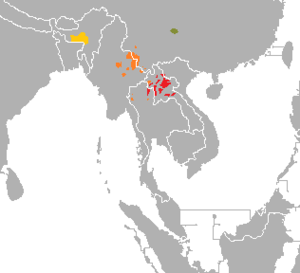Khasic languages
The Khasic or Khasian languages are a family of Austroasiatic languages spoken in the northeastern Indian state Meghalaya and neighbouring areas of Bangladesh.
| Khasic | |
|---|---|
| Geographic distribution | India and Bangladesh |
| Linguistic classification | Austroasiatic
|
| Proto-language | Proto-Khasic |
| Glottolog | khas1268[1] |
 Khasic | |
Languages
Sidwell (2018: 27–31) classifies the Khasian languages as follows.
- proto-Khasian
- War (Amwi, Mnar)
- proto–Pnar-Khasi-Lyngngam
Varieties called Bhoi are dialects of both Pnar and Khasi.
External relationships
Paul Sidwell (2011) suggests that Khasian is closely related to Palaungic, forming a Khasi–Palaungic branch.
The following eight Khasian-Palaungic isoglosses have been identified by Sidwell (2018: 32).
| Gloss | Proto-Khasian (Sidwell 2018) | Proto-Palaungic (Sidwell 2015)[2] |
|---|---|---|
| blood | *snaːm | *snaːm |
| claw/nail | *trʧʰiːm | *rənsiːm |
| hair | *sɲuʔ | *ɲuk |
| man/husband | trmɛ (Amwi) | *-meʔ |
| rain | *slap; slɛ (Amwi) | *clɛʔ |
| swim | *ɟŋiː | *ŋɔj |
| two | *ʔaːr | *ləʔaːr |
| water | *ʔum | *ʔoːm |
Lexical innovations
Sidwell (2018: 23) lists the following Khasian lexical innovations (i.e., defining lexical forms) that are found exclusively in the Khasian branch, but not in other Austroasiatic branches).
| English gloss | Proto-Khasian | Lyngngam | Maram | Khasi | Pnar | Mnar | War |
|---|---|---|---|---|---|---|---|
| cooked rice | *ʤaː | ʥa | ʤa | ja /ʤaː/ | ʤa | ci | ʧi |
| moon | *bnəːj | bni | bne | bnai /bnaːi/ | bnaj | pni | pnʊ |
| to sing | *rwəːj | rəŋwi | rwej | rwái /rwaːi/ | rwaj | – | rvʊ |
| four | *saːw | saw | saw | sáw /saːw/ | so | sɔu | ria |
| river | *waʔ | – | waɁ | wah /waːʔ/ | waɁ | waɁ | waɁ |
| all | *barɔɁ | prok | barɔʔ | baroh /barɔːʔ/ | warɔʔ | – | bərɒʔ |
| pig | *sniaŋ | sɲaŋ | sniaŋ | sniang /sniaŋ/ | sniaŋ | cʰɲaŋ | rniŋ |
| sand | *ʧʔiap | ʥʔep | ʧiʔɛp | shyiap /ʃʔiap/ | ʧʔiap | ʃʔip | ʃʔiap |
| to drink | *di:ʔ/c | dec | dɔc | dih /diːʔ/ | diʔ | deʔ | deʔ |
| flower/star | *kʰloːr | kʰlor | kʰlɔr | khlúr /kʰloːr/ | kʰlor | – | khlʊə |
| tongue | *tʰnləːc | təloc | tʰl̩let | thyllied /tʰɨlleːc/ | tʰl̩leɟ | kʰlut | kʰlit |
| ice/freeze | *tʰaʔ | tʰaʔ | tʰaʔ | thah /tʰaːʔ/ | tʰaʔ | tʰaʔ | tʰaʔ |
Reconstruction
Proto-Khasian and Proto-Pnar-Khasi-Lyngngam have been reconstructed by Paul Sidwell (2018). Proto-Khasian is estimated to have originated about 2,000-2,500 years ago, with War splitting from other Khasian linguistic varieties about 1,500 years ago (Sidwell 2018: 20).
Proto-Khasian morphology includes a causative *pN- prefix and verbalizing *-r- infix (Sidwell 2018: 66-67).
The following reconstructed paradigmatic and closed class morphemes in Proto-Khasian are from Sidwell (2018: 51-67).
- Personal pronouns
| Masculine | Feminine | Plural | |
|---|---|---|---|
| 1st person | *ŋa (topic/oblique); *ʔɔ (default) | *ŋa (topic/oblique); *ʔɔ (default) | *ʔi |
| 2nd person | *me | *pʰa | *pʰi |
| 3rd person (animate) |
*ʔu | *ka | *ki |
| 3rd person (inanimate ~ diminutive) |
*ʔi | *ʔi | *ʔi |
- Demonstratives
- *ni 'proximal'
- *tu 'mesiodistal'
- *taj 'distal (visible)'
- *te 'mesioproximal'
- *tɛ 'distal (non-visible)'
- Negators
- *ʔǝm 'not'
- *ham 'do not'
- *ta 'not'
- Prepositions/case markers
- *ha 'locative/oblique'
- *ʤɔŋ 'to possess'
- *da 'instrumental'
- *ba (?) 'and/with'
- *tV 'oblique'
- Tense/aspect morphemes
- *la:j 'to go'
- *dɛp 'finish'
- *diʔ 'to go'
- *daː 'have'
- *ʤuʔ 'same'
- Morphological affixes
- *pN- 'prefix'
- *-r- 'verbalizer'
- Numerals
| Gloss | Proto-Khasian | Proto-Pnar- Khasi-Lyngngam |
|---|---|---|
| one | *wiː~*miː | |
| one | *ʧiː | |
| two | *ʔaːr | |
| three | *laːj | |
| four | *saːw | |
| five | *san | |
| six | *tʰruː | |
| seven | *ʰnɲəw | |
| eight | *pʰraː | |
| nine | *kʰndaːj | |
| ten | *pʰəw |
Sound changes
Sidwell (2018) lists the following sound changes from Pre-Khasian (i.e., the ancestral stage of Khasian that preceded Proto-Khasian) to Proto-Khasian.
- Pre-Khasian *b- > *p-, *ɓ- > *b- chain shift
- Proto-Austroasiatic *b- > proto-Khasian *p-
- Proto-Austroasiatic *ɓ- > proto-Khasian *b-
- Pre-Khasian *d- > *t-, * ɗ- > *d- chain shift
- Proto-Austroasiatic *d- > proto-Khasian *t-
- Proto-Austroasiatic *ɗ- > proto-Khasian *d-
- Pre-Khasian *-l > *-n/*-Ø
- Pre-Khasian *-h > *-s > *-t
- Pre-Khasian *-ʔ > *-Ø >, *-k > *-ʔ chain shift
- Pre-Khasian *g- > *k-
See also
- List of Proto-Khasian reconstructions (Wiktionary)
References
- Hammarström, Harald; Forkel, Robert; Haspelmath, Martin, eds. (2017). "Khasian". Glottolog 3.0. Jena, Germany: Max Planck Institute for the Science of Human History.
- Sidwell, Paul. 2015. The Palaungic Languages: Classification, Reconstruction and Comparative Lexicon. München: Lincom Europa.
- Sidwell, Paul. 2011. Proto-Khasian and Khasi-Palaungic. Journal of the South East Asia linguistics society, Vol. 4.2, pages 144-168, December 2011.
- Sidwell, Paul. 2011b. Proto-Khasian (or -War-Khasi); reconstruction and classification. Presented at SEALS 21, Kasetsart University, Bangkok, Thailand.
- Sidwell, Paul. 2018. The Khasian Languages: Classification, Reconstruction, and Comparative Lexicon. Languages of the World 58. Munich: Lincom Europa. ISBN 9783862889143